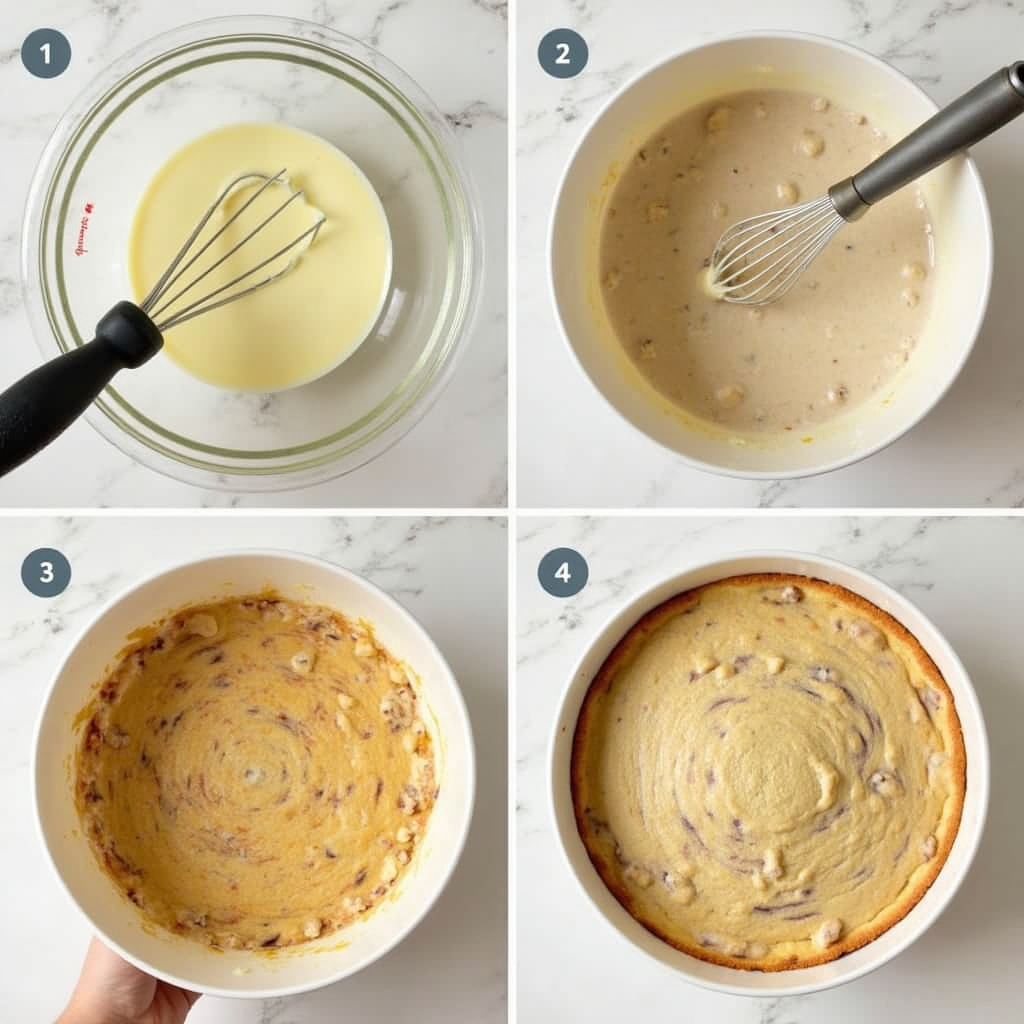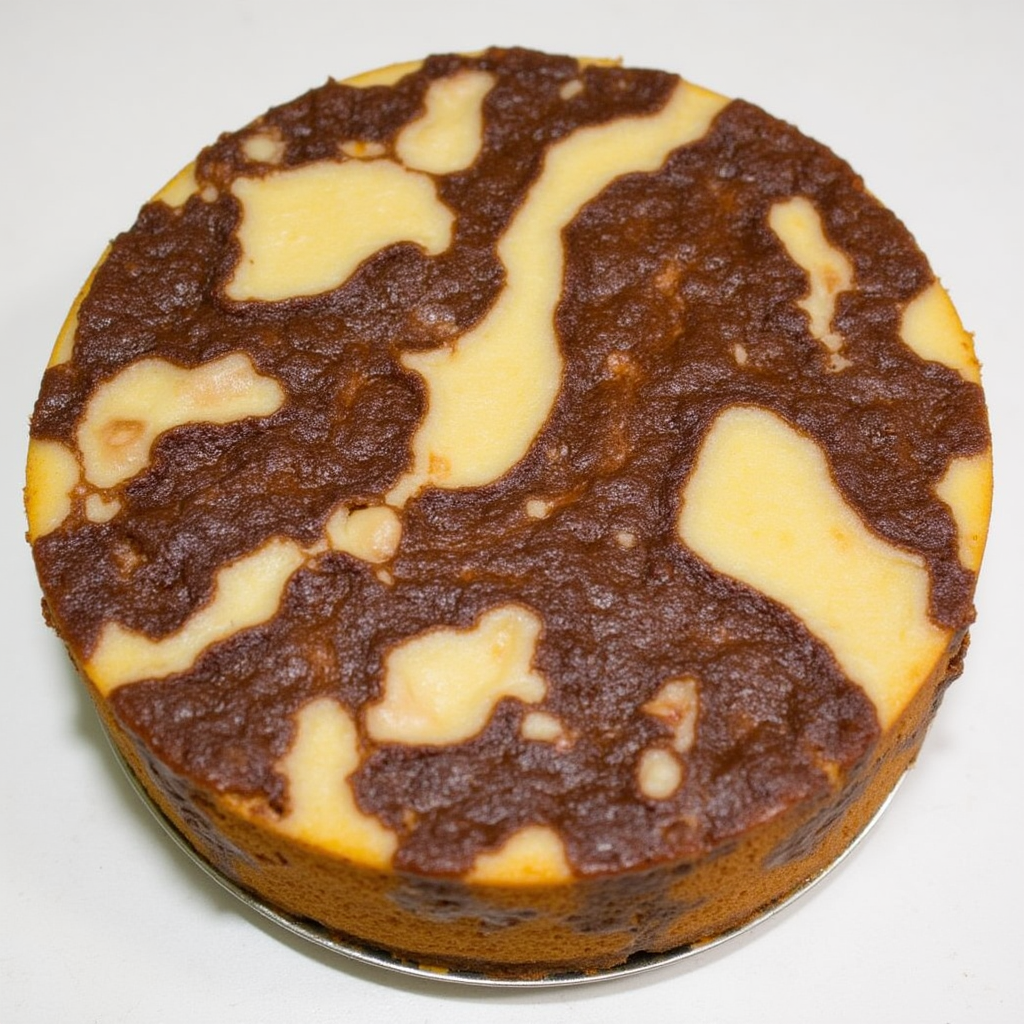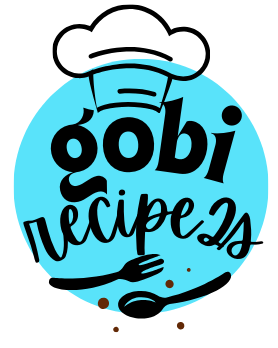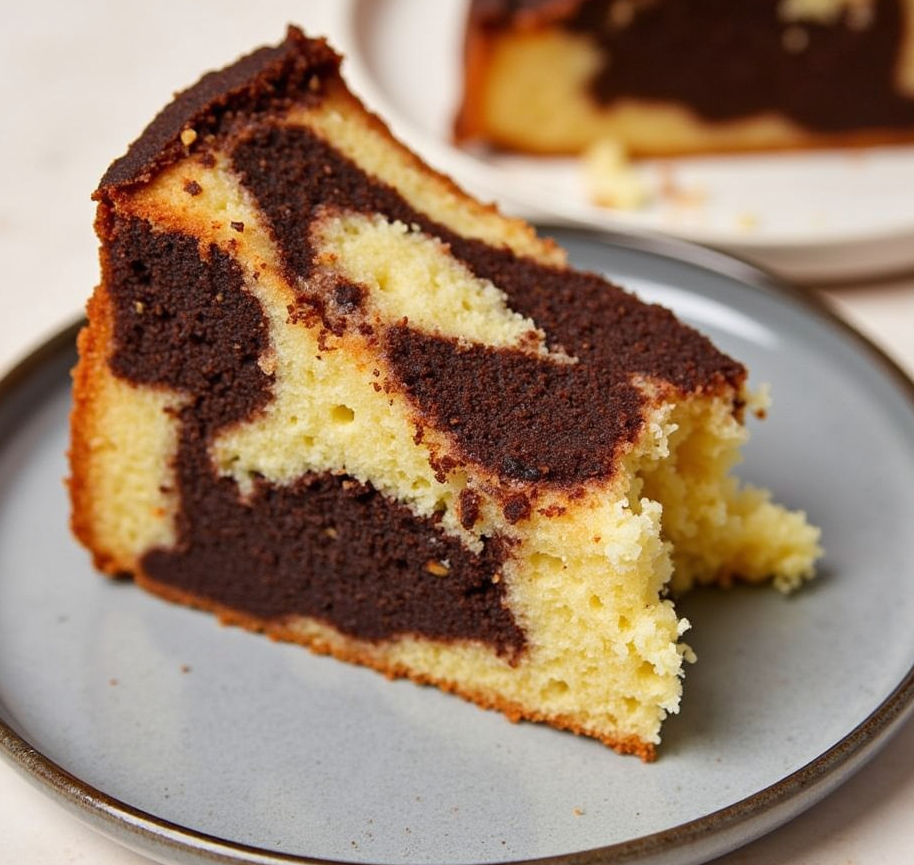A Classic Marble Cake is a delightful fusion of vanilla and chocolate flavors, creating a visually stunning swirl effect. The key to achieving this perfect marbling lies in the technique of layering and swirling the batter correctly. A well-made Classic Marble Cake is not only light and fluffy but also moist, ensuring a satisfying texture with every bite.
In this guide, we will cover everything from the history of this beloved dessert to essential baking tips and ingredient choices. Whether you are a novice baker or an experienced one looking to perfect your technique, this article will provide valuable insights. By following a well-structured process and using high-quality ingredients, you can bake a Classic Marble Cake that is as pleasing to the eye as it is to the palate.
Let’s begin by understanding what makes this cake so special.
What Is a Classic Marble Cake?
A Classic Marble Cake is a combination of two flavors—typically vanilla and chocolate—swirled together to create a marbled effect. The contrast between the light vanilla and deep cocoa results in a rich and visually appealing dessert. This cake is often baked in a loaf or bundt pan, allowing the marbling to appear prominently when sliced.
The process involves preparing a single batter, then dividing it into two portions—one flavored with cocoa powder or melted chocolate. These batters are then layered and gently swirled before baking, creating the signature marbled appearance. The result is a soft, moist, and buttery cake that offers a perfect balance of sweetness and richness.
Many variations exist, including versions with coffee, caramel, or nut-based flavors. Despite its simplicity, a well-made Classic Marble Cake stands out due to its intricate swirl and deep flavor combination.
The History and Origin of Marble Cake
The origins of Classic Marble Cake can be traced back to 19th-century Germany, where bakers first experimented with blending light and dark batters. This technique, known as “Marmor” in German, was brought to America by European immigrants, where it quickly gained popularity.
During the early 20th century, American bakers began incorporating chocolate into the marbling process, creating the modern version recognized today. Before the widespread availability of chocolate, early variations often used molasses or spices to achieve contrast in color and taste.
Over time, the Classic Marble Cake has evolved into a staple in bakeries and homes worldwide. Its popularity continues due to its simplicity, aesthetic appeal, and the delightful combination of flavors. Whether served as a tea-time snack or a dessert for special occasions, this cake remains a timeless favorite.
Key Ingredients for a Moist and Fluffy Marble Cake
The secret to a perfectly textured Classic Marble Cake lies in using high-quality ingredients. Each component plays a vital role in achieving the desired flavor and consistency.
Must-Have Ingredients:
- All-purpose flour – Provides structure and stability.
- Unsalted butter – Adds richness and moisture.
- Granulated sugar – Sweetens the cake while aiding in aeration.
- Eggs – Contribute to structure and provide tenderness.
- Whole milk – Enhances moisture and softens the texture.
- Vanilla extract – Brings out the sweet, aromatic flavor.
- Cocoa powder – Used for the chocolate portion of the batter.
- Baking powder – Ensures a light and fluffy texture.
- Salt – Balances sweetness and enhances flavor.
By measuring ingredients accurately and using fresh, high-quality components, you can achieve a moist and tender Classic Marble Cake every time.
Essential Baking Tools for a Perfect Bake
To bake a flawless Classic Marble Cake, having the right tools is essential. Proper equipment ensures even baking, precise mixing, and a professional finish.
Necessary Tools:
- Mixing bowls – Needed for preparing and combining ingredients.
- Electric mixer – Helps achieve a smooth and well-incorporated batter.
- Sifter – Prevents lumps in flour and cocoa powder.
- Loaf or bundt pan – Shapes the cake and enhances presentation.
- Offset spatula – Aids in layering and spreading the batter evenly.
- Toothpick or skewer – Checks doneness without damaging the cake.
- Wire rack – Allows the cake to cool evenly, preventing sogginess.
Investing in quality baking tools not only simplifies the process but also improves the final outcome of your Classic Marble Cake.
Step-by-Step Guide to Making a Classic Marble Cake

1. Prepare the Ingredients
Gather all ingredients and allow them to reach room temperature for even mixing.
2. Mix the Batter
Cream butter and sugar until light and fluffy, then gradually add eggs and vanilla extract. Sift in the dry ingredients and alternate with milk for a smooth consistency.
3. Create the Chocolate Batter
Divide the batter into two portions. Mix cocoa powder with a bit of milk into one portion to create the chocolate variation.
4. Layer the Batter
Alternate spoonfuls of vanilla and chocolate batter into the baking pan, creating layers.
5. Swirl for the Marble Effect
Use a skewer or knife to gently swirl the batters together for a marbled look.
6. Bake to Perfection
Bake at 350°F (175°C) until a toothpick inserted in the center comes out clean.
7. Cool and Serve
Let the cake cool completely before slicing to maintain its structure.
How to Achieve the Perfect Marble Swirl
The signature swirl in a Classic Marble Cake requires precision. Here’s how to perfect it:
- Use a gentle swirling motion – Overmixing will blend the batters too much, losing the contrast.
- Employ a skewer or knife – Drag through the batter in an “S” or figure-eight pattern.
- Avoid deep swirling – Keeping the motion on the surface creates a more defined marbling effect.
Practicing this technique ensures a visually striking and well-balanced swirl in every slice.
Common Mistakes and How to Avoid Them
Even experienced bakers can encounter issues when making a Classic Marble Cake. Here’s how to prevent common pitfalls:
- Dense texture – Overmixing the batter leads to a tough cake. Mix only until combined.
- Dryness – Use whole milk and butter for moisture, and avoid overbaking.
- Uneven marbling – Distribute batters evenly and swirl lightly for consistent patterns.
By following these tips, your Classic Marble Cake will turn out soft, flavorful, and visually appealing.
Variations of Marble Cake for Different Flavors
While the classic vanilla and chocolate combination remains popular, you can experiment with different flavors:
- Coffee Marble Cake – Add espresso powder to enhance the chocolate flavor.
- Caramel Swirl Marble Cake – Mix in caramel sauce for added sweetness.
- Nutty Marble Cake – Incorporate ground almonds or hazelnuts for a richer texture.
These variations allow you to customize your Classic Marble Cake while maintaining its signature swirl.
Gluten-Free and Vegan Alternatives for Marble Cake
For those with dietary restrictions, there are excellent substitutions to create a gluten-free or vegan Classic Marble Cake:
- Gluten-free flour blend – Replaces regular flour without compromising texture.
- Vegan butter or coconut oil – Provides richness without dairy.
- Flaxseed or applesauce – Serves as an egg replacement for structure.
- Almond or oat milk – Keeps the batter moist and flavorful.
By adjusting the ingredients, you can enjoy a delicious Classic Marble Cake that suits different dietary needs.
Best Frosting and Topping Ideas for Marble Cake

A Classic Marble Cake is delicious on its own, but the right frosting and toppings can elevate its taste and presentation. The choice of frosting depends on the occasion and personal preference, whether you prefer a rich buttercream, a light glaze, or a simple dusting of powdered sugar.
Popular Frosting Options:
- Chocolate Ganache – A glossy, smooth layer of melted chocolate and cream enhances the cake’s richness.
- Vanilla Buttercream – Creamy and slightly sweet, it complements both the chocolate and vanilla flavors.
- Cream Cheese Frosting – Offers a tangy contrast that balances the cake’s sweetness.
- Whipped Cream Frosting – Light and airy, perfect for a less dense topping.
Creative Topping Ideas:
- Fresh Berries – Adds a refreshing touch and a pop of color.
- Chopped Nuts – Almonds, walnuts, or hazelnuts provide a crunchy texture.
- Shredded Coconut – A subtle sweetness that pairs well with chocolate.
- Caramel Drizzle – Enhances the cake with a buttery, sugary depth.
Customizing your Classic Marble Cake with different frostings and toppings allows for a unique and personalized dessert experience.
How to Store and Preserve Your Marble Cake
Proper storage of a Classic Marble Cake ensures it remains moist and flavorful for days. Whether you plan to enjoy it immediately or save it for later, using the right storage methods is crucial.
Short-Term Storage (1-2 Days):
- Keep the cake in an airtight container at room temperature.
- If frosted, store it in the refrigerator to prevent melting.
Long-Term Storage (Up to 1 Week):
- Wrap the cake tightly in plastic wrap, then place it in an airtight container.
- Refrigerate it to extend freshness, especially if it contains dairy-based frostings.
Freezing for Extended Preservation (Up to 3 Months):
- Wrap individual slices in plastic wrap and then in aluminum foil.
- Place them in a freezer-safe bag to prevent freezer burn.
- To thaw, leave the cake at room temperature for a few hours before serving.
By following these storage techniques, you can enjoy your Classic Marble Cake while maintaining its quality and taste.
Serving Suggestions for Special Occasions
A Classic Marble Cake is versatile and fits well into various celebrations. Whether it’s a birthday, holiday gathering, or casual tea time, presenting it beautifully enhances the dining experience.
For Formal Occasions:
- Layered with Frosting – A multi-layered cake with buttercream or ganache makes a stunning centerpiece.
- Decorated with Edible Flowers – Adds elegance for weddings or anniversaries.
Casual Gatherings:
- Served with Ice Cream – Vanilla, chocolate, or caramel ice cream pairs wonderfully.
- Drizzled with Honey or Maple Syrup – A simple yet flavorful touch.
For Festive Holidays:
- Christmas Theme – Garnish with red and green sprinkles or crushed peppermint.
- Easter Brunch – Pair with fresh fruit and a light glaze.
By tailoring the presentation, a Classic Marble Cake can complement any occasion while delighting guests.
Health Benefits of Homemade Marble Cake
While a Classic Marble Cake is considered a treat, a homemade version offers several benefits compared to store-bought options. By using fresh, natural ingredients, you can create a healthier alternative with fewer preservatives and artificial additives.
Nutritional Advantages:
- Controlled Sugar Levels – Adjusting the sugar content helps manage calorie intake.
- Better Quality Fats – Using real butter or healthier oil alternatives reduces trans fats.
- No Artificial Additives – Homemade cakes avoid unnecessary preservatives.
Ways to Make It Healthier:
- Substitute whole wheat flour for extra fiber.
- Use Greek yogurt or applesauce instead of butter for lower fat content.
- Choose dark chocolate over milk chocolate for added antioxidants.
By making a Classic Marble Cake from scratch, you can enjoy a delicious dessert while keeping it as wholesome as possible.
Frequently Asked Questions About Marble Cake

1. Why is my marble cake dry?
A dry Classic Marble Cake is often the result of overbaking or using too little fat. To maintain moisture, bake at the recommended temperature and check for doneness using a toothpick.
2. How do I get a more pronounced swirl pattern?
To create a well-defined marbling effect, alternate layers of vanilla and chocolate batter and gently swirl with a skewer. Avoid overmixing, as this can blend the batters too much.
3. Can I use melted chocolate instead of cocoa powder?
Yes, melted chocolate enhances the chocolate flavor and provides a richer texture. However, adjust the liquid content in the recipe to maintain balance.
4. What is the best way to make a gluten-free marble cake?
Use a high-quality gluten-free flour blend and add a binding agent like xanthan gum to prevent the cake from becoming too crumbly.
5. How do I make a vegan marble cake?
Replace eggs with flaxseed meal or applesauce, use plant-based milk, and opt for vegan butter or coconut oil.
Understanding these common concerns ensures a better baking experience when preparing a Classic Marble Cake.
Conclusion
A perfectly baked Classic Marble Cake is a timeless dessert that combines both aesthetic appeal and rich flavor. Whether you are experimenting with different frostings, customizing it for a special occasion, or seeking a healthier alternative, this cake remains a versatile favorite.
By following proper baking techniques, storing it correctly, and using high-quality ingredients, you can enjoy a soft, moist, and beautifully marbled cake every time. Whether served with coffee, topped with fresh fruit, or layered with frosting, a Classic Marble Cake never fails to impress.

